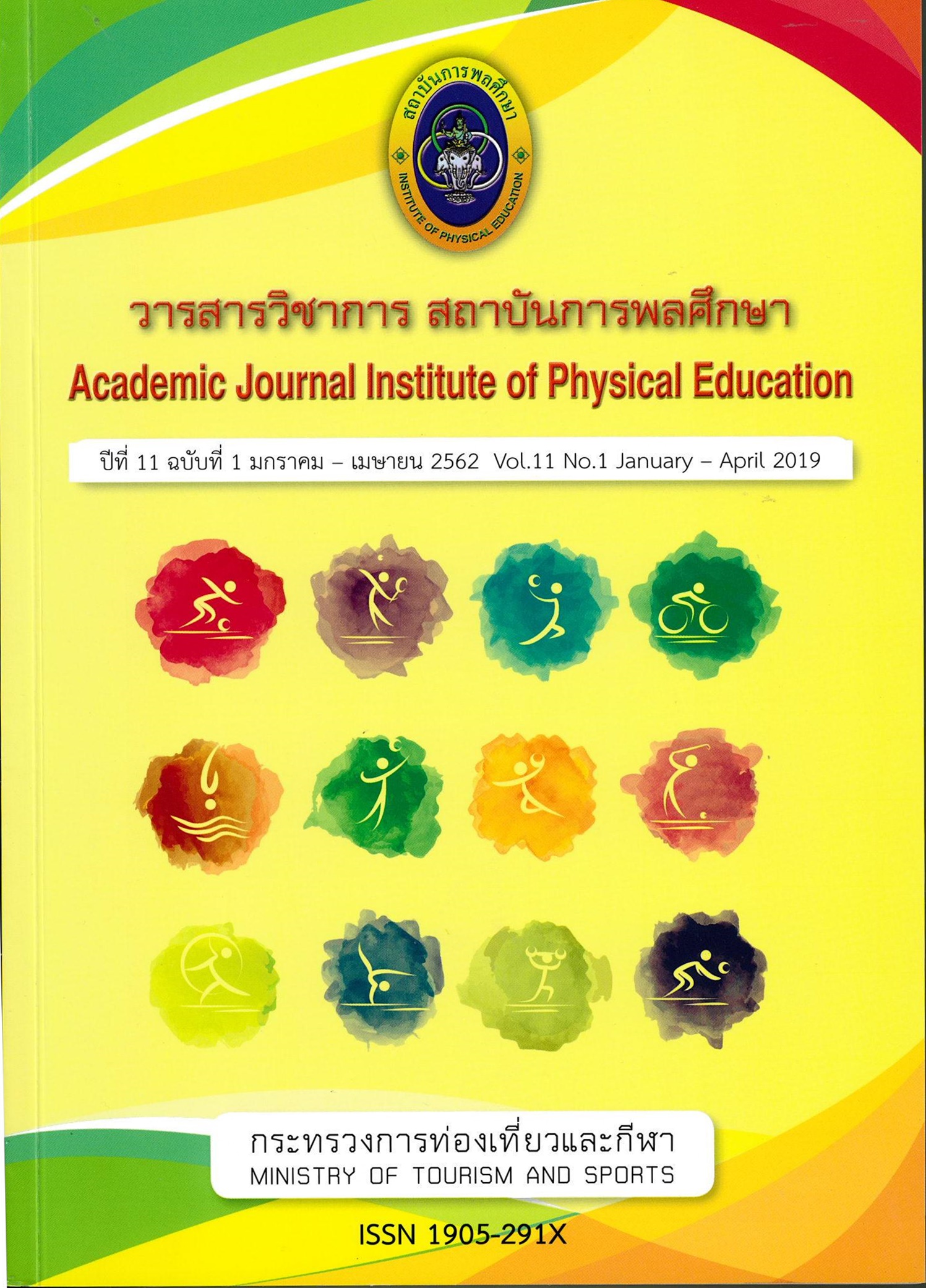THE CRITERIA IN DECISION MAKING SELECTION OF EXCLUSIVE DISTRIBUTOR OF SPORTS SCIENCE PRODUCT MANUFACTURER
Main Article Content
Abstract
The objectives of this research are following; 1) to study the criteria in decision making selection of exclusive distributor of Sports Science Product Manufacturer 2) to construct forecasting equation of the criteria in decision making selection of exclusive distributor of Sports Science Product Manufacturer. The quantitative research was divided into three groups by purposive sampling totally 147 persons who joined in Seoul International Sport and Leisure Industry Show 2017 (Feb23-26, 2017in SPOEX 2017) at COEX Convention& Exhibition Center. Comprising with product manufacturers, marketing personals, branding owners and sport product’s manufacturers who have foreign distributors already. The tool for collecting data was questionnaire composed of 64 questions which was approved by three experts. Conbach’s alpha coefficients used to estimate the internal consistency reliability was acceptable ( =0.978). The questionnaire consisted of personal information and the 7 criterions of decision making selection of exclusive distributor of Sports Science Product Manufacturer.
The research was found that the variables which are the weighted significance on forecasting variable affected of the criteria in decision making selection of exclusive distributor of Sports Science Product Manufacturer, were sorted by descending order as follow; criteria on image and facilities (X7) which rated the weighted significance in standard rating approximately 0.590, Criteria on financial aspect and stability of company (X1) approximately 0.152, Criteria on relationship (X3) approximately 0.096, Criteria on collaboration (X6) approximately .087, Criteria on marketing (X2) approximately 0.048, Criteria on ability of warehouse management (X4) approximately 0.036 and Criteria on products and services (X5) approximately 0.028. Moreover, it was revealed that Multiple Correlation has significant different on statistics at level of .01 and multiple correlation coefficient is 0.904, and square coefficient of selecting, the independent variable influenced criteria variable (Y) or Criteria of selection is 0.816 or approximately 81.6%.
The Equation of Forecast in Standard point is :
Z' = .590 (Z7) + .152 (Z1) + .096 (Z3) + .087 (Z6) + .048 (Z2) + .036(Z4) + .028 (Z5)
The Equation of Forecast in Raw Score is :
Y' = .612 (X7) + .149 (X1) + .098(X3) +.087 (X6) + .051 (X2) .028 (X4) + .028 (X5) - .005
The criteria decision to select distributors is one of the most important issues in channel management for manufacturers. Our empirical findings are quite supportive of the conceptual framework to explore dimensions of distributor selection. The seven key factors in our model all have positive and significant effects on manufacturers’ selection of distributors, with all seven hypotheses fully supported. This indicates that manufacturers, when selecting distributors, pay attention to not only distributors’ facilitating & Image, but also distributor’s financial & company strengths, relationship intensity, commitment, the marketing capability, logistics capabilities and Products and Service.
Article Details
The published article is a copyright of the Academic Journal of Thailand National Sports University. The passage appeared in each article in this academic journal is a perspective of each author which is not related to the journal. Each author is required to be responsible for all components of his/her own article. If there are any mistakes, each author must be responsible for those mistakes on his/her own.
References
ธีรวุฒิ เอกะกุล. 2543. ระเบียบวิธีวิจัยทางพฤติกรรมศาสตร์และสังคม. อุบลราชธานี: สถาบันราชภัฏอุบลราชธานี.
ปนัดดา แก้วตรีวงษ์. 2549. ความสัมพันธ์ระหว่างศักยภาพทางนวัตกรรมกับผลประกอบการของธุรกิจส่งออกอิเล็กทรอนิกส์เครื่องใช้ไฟฟ้าและอุปกรณ์. บริหารธุรกิจมหาบัณฑิต สาขาวิชาการจัดการตลาด, มหาวิทยาลัยมหาสารคาม.
มนต์ชัย พัดน้อย. 2551. ความสัมพันธ์ระหว่างปัจจัยทางการตลาดที่มีผลต่อการเกิดความภักดีต่อตราสินค้า บริษัทประกันวินาศภัย. วิทยานิพนธ์ มหาวิทยาลัยบูรพา.
สัมมนา สีหมุ่ย. 2553. การศึกษาประสิทธิภาพการทางานเป็นทีมของบุคลากรองค์การบริหารส่วนตำบลในเขตอำเภอโนนไทย จังหวัดนครราชสีมา. การศึกษาตามหลักสูตรปริญญามหาบัณฑิต มหาวิทยาลัยเทคโนโลยีสุรนารี.มหาวิทยาลัยธรรมศาสตร์.
อนันต์ เกตุวงค์. 2534. หลักและเทคนิคการวางแผน. พิมพ์ครั้งที่ 5. กรุงเทพฯ: โรงพิมพ์มหาวิทยาลัยธรรมศาสตร์ .
Abratt, R. and L.F. Pitt. 1989, “Selection and Motivation of industrial distributor: a comparative analysis,” European Journal of Marketing, 23 (2): 144-53.
Abratt, R., J. L. C. Fourie and L. F. Pitt, 1985, Tenant mix: the key to a Successful Shopping Centre', Quarterly Review of Marketing, Vol. 10, No. 3.
Briglia, M. and A. Petroni. 2000. “A quality assurance- oriented methodology for handing trade-offs in supplier selection” International Journal of Physical Distribution & Logistic Management, 30 (2): 96-111.
Cavusgil, S.T., P.L. Yeoh and M. Mitri. 1995. 'Selecting foreign distributors: An expert systems approach', Industrial Marketing Management, 24 (4): 297–304.
Dacin, M.T., M.A. Hitt and E. Levitas. 1997. Selecting partners for successful international alliances: Examination of U.S. and Korean firms. Journal of World Business, 32: 3-16.
Da Silva, R.V., G. Davies and P. Naude. 2002. “Assessing customer orientation in the context of buyer/supplier relationships using judgmental modeling,” Industrial Marketing Management, 31(31): 241-52.
Fawcett, S.E., L.L. Stanley and S.R. Smith. 1997. “Developing a logistics capability to improve the performance of international operations.” Journal of business logistics, 18 (2): 101-27.
Kaleka, A. 2002. “Resources and capability driving competitive advantage in export markets: guidelines for industrial exporters.” Industrial Marketing Management. 31(4): 273-83
Morash, E.A., C.L.M. Groge and S.K. Vickery. 1996. “Strategic logistics capability for competitive advantage and firm success.” Journal of business logistics, 17(1): 1-22
Shankar, V. 1999. “New product introduction and incumbent response strategies: their inter-relationship and the role of multimarket contact.” Journal of Marketing Research, 36(9): 327-44.
Vickery, S., R. Calantone and C. Drooge. 1999. “Supply Chain Flexibility: an empirical study.” Journal of Supply Chain Management: A Global Review of Purchasing & Supply, 35 (3): 16-24.


